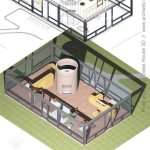Exploring the World of House Plan Images: A Visual Guide to Design and Functionality
House plans are fundamental blueprints for any residential construction project. Before hammers swing and bricks are laid, a well-defined house plan serves as the roadmap, detailing the layout, dimensions, and features of the future home. Complementing these technical drawings are house plan images, which provide a visual representation of the design, allowing clients and builders to better understand the aesthetic and spatial qualities of the planned structure. These images can range from simple floor plan illustrations to elaborate 3D renderings, each offering a unique perspective on the architectural design.
The purpose of house plan images is multifaceted. They serve as a vital communication tool, enabling architects, builders, and homeowners to visualize the intended design and identify potential issues before construction begins. High-quality images can inspire design choices, showcase the home's character, and aid in marketing efforts. Ultimately, house plan images contribute to a smoother, more efficient, and more satisfying building process.
This article delves into the different types of house plan images, their uses, and the key elements to consider when selecting and interpreting them. It aims to provide a comprehensive understanding of how these visual aids contribute to the successful realization of a residential building project.
Understanding Different Types of House Plan Images
House plan images encompass a wide array of visual representations, each serving a distinct purpose and offering unique insights into the proposed design. These can be broadly categorized into floor plan illustrations, elevation drawings, 3D renderings, and virtual tours.
Floor plan illustrations are top-down views of each level of the house, depicting the layout of rooms, hallways, and other spaces. These illustrations typically include dimensions, door and window placements, and the location of key fixtures such as plumbing and electrical outlets. Floor plans provide a functional understanding of the spatial relationships within the home and are essential for planning furniture layout and understanding traffic flow.
Elevation drawings showcase the exterior facades of the house from different perspectives, typically front, rear, and sides. Elevations depict the architectural style, rooflines, window and door designs, and exterior materials. These drawings are crucial for visualizing the overall aesthetic and understanding how the house will integrate with its surroundings. They also play a vital role in obtaining building permits and ensuring compliance with local zoning regulations.
3D renderings offer a more realistic and immersive visualization of the house, often depicting interior and exterior views. These renderings utilize computer graphics to create photorealistic images that showcase the house with lighting, textures, and landscaping. 3D renderings are particularly helpful for understanding the overall design aesthetic, visualizing the spatial volume of rooms, and exploring different material and color palettes. They are often used for marketing purposes and to help clients make informed design decisions.
Virtual tours take the visualization a step further by allowing users to virtually walk through the house and experience the space interactively. These tours can be created using 3D models and allow users to explore different rooms, change viewing angles, and even interact with certain elements within the environment. Virtual tours are an invaluable tool for understanding the spatial flow and overall feel of the house before construction begins.
Utilizing House Plan Images for Effective Communication and Design Decision Making
The effectiveness of house plan images lies in their ability to facilitate clear communication between all stakeholders involved in the building process. Architects use these images to convey their design vision to clients and builders. Builders rely on them to understand the specific details of the construction and ensure accurate execution. Homeowners utilize them to visualize their future living space and make informed decisions about the design and features of their home.
When selecting house plans, images are a crucial factor in the decision-making process. They allow potential homeowners to assess the aesthetic appeal of the design and determine if it aligns with their personal tastes and lifestyle. By carefully reviewing floor plan illustrations, elevations, and 3D renderings, buyers can evaluate the functionality of the layout, the size and proportion of rooms, and the overall design of the house.
Furthermore, house plan images can be used to identify potential design flaws or areas for improvement before construction begins. For example, a 3D rendering might reveal an awkward roofline or an undesirable window placement. By catching these issues early, costly changes during construction can be avoided. Clients can also leverage the images to experiment with different color palettes, material selections, and furniture arrangements, ensuring that the finished product meets their expectations.
For builders, house plan images serve as a valuable reference during the construction process. Elevations provide details about exterior finishes and architectural features, while floor plans illustrate the precise location of walls, doors, windows, and fixtures. By referring to these images, builders can minimize errors, ensure accurate execution, and ultimately deliver a high-quality finished product.
Effective use of house plan images requires a discerning eye and a thorough understanding of architectural principles. It is essential to consider the scale and proportion of different elements, the relationship between interior and exterior spaces, and the overall flow of the design. By paying attention to these details, homeowners and builders can leverage house plan images to create a home that is both aesthetically pleasing and functionally efficient.
Key Elements to Consider When Analyzing House Plan Images
Interpreting house plan images effectively requires attention to detail and a critical understanding of the information they convey. Several key elements should be considered when analyzing these images to ensure a comprehensive understanding of the proposed design.
First, the scale of the image is crucial. Understanding the scale allows for accurate interpretation of dimensions and proportions. Floor plans typically include a scale bar that indicates the relationship between the drawing and the actual size of the rooms. Pay close attention to this scale when evaluating the size of rooms, hallways, and other spaces. A room that appears large in the image may actually be quite small in reality.
Second, the level of detail in the image is an important factor. Floor plans should clearly indicate door and window placements, as well as the location of plumbing and electrical fixtures. Elevations should accurately depict the architectural style, rooflines, and exterior materials. 3D renderings should showcase the textures, colors, and lighting of the house. The more detailed the image, the better the understanding of the design.
Third, the perspective of the image should be considered. Floor plans are always top-down views, while elevations are typically orthogonal projections. 3D renderings can be presented from various viewpoints, but it is important to understand the angle and framing of the image to accurately assess the design. For example, a wide-angle rendering can make a room appear larger than it actually is.
Fourth, the consistency of the images across different types is crucial. The floor plans, elevations, and 3D renderings should all accurately reflect the same design. Discrepancies between these images can indicate errors or inconsistencies in the plans. Always cross-reference different images to ensure that they are aligned and consistent.
Finally, the visual clarity of the images is paramount. The images should be well-rendered, clearly labeled, and easy to understand. Blurry or distorted images can be difficult to interpret and can lead to misunderstandings. Always request high-resolution images that are free from artifacts or distortions.
By carefully considering these key elements, homeowners, architects, and builders can effectively analyze house plan images and make informed decisions about the design and construction of their homes. This careful analysis ensures that the final product meets their expectations and fulfills their needs.

House Plans How To Design Your Home Plan

House Plans How To Design Your Home Plan

Pin On Κατόψεις

House Plans How To Design Your Home Plan

Where You Can Buy House Plans Live Home 3d

3 Bedroom House Plans Home Designs Nethouseplans

House Plans With Photos

Peach Tree House Plan Ranch Floor Designs

House Plans How To Design Your Home Plan

House Plan Maywood Sater Design Collection








